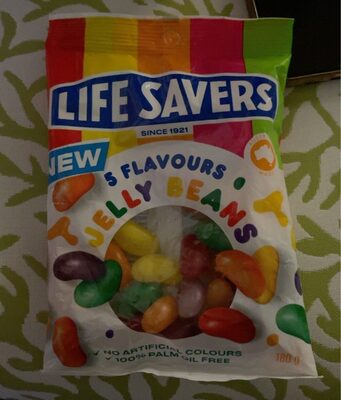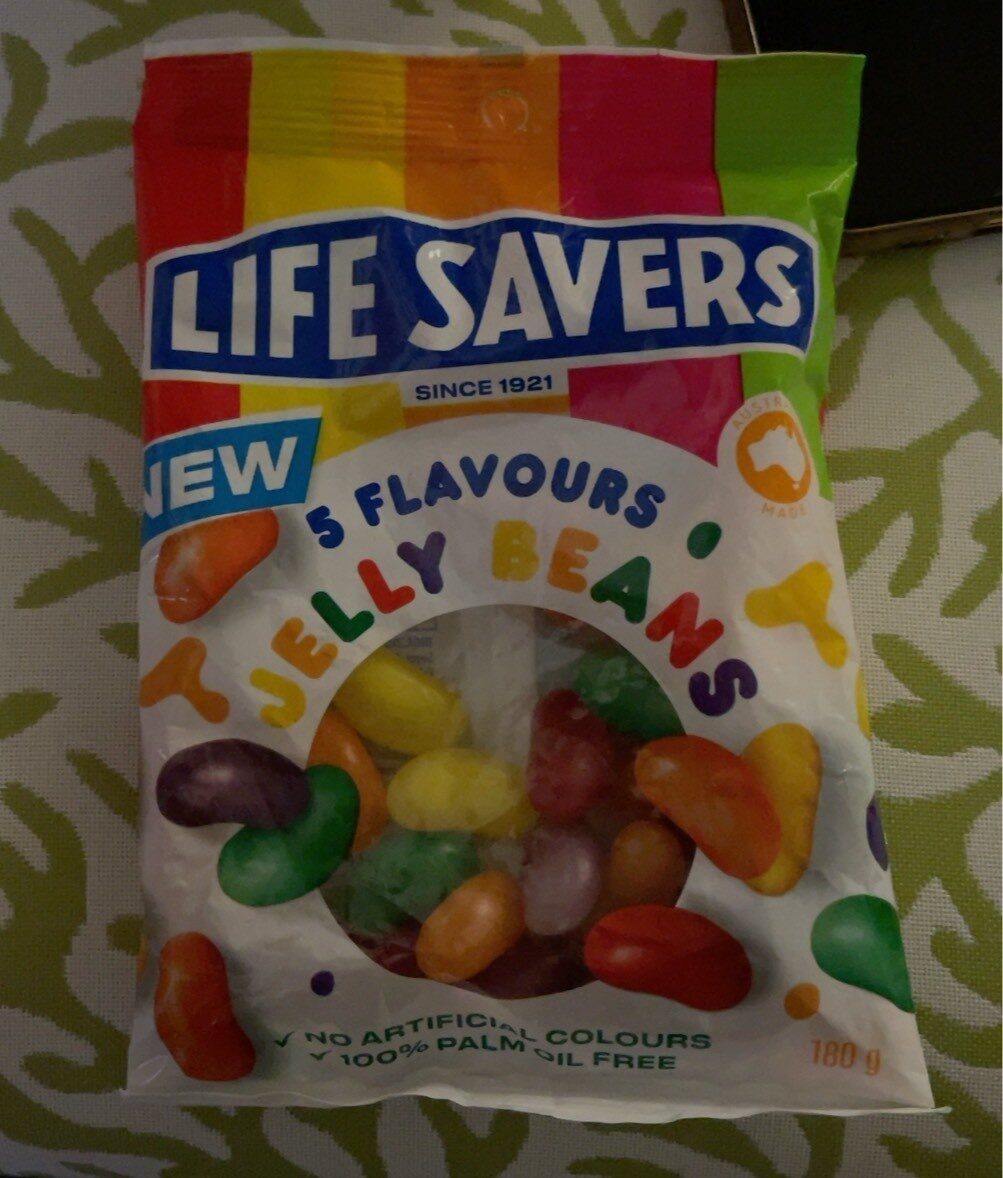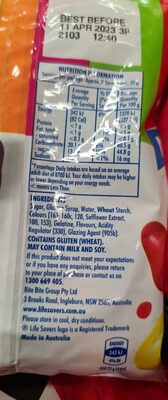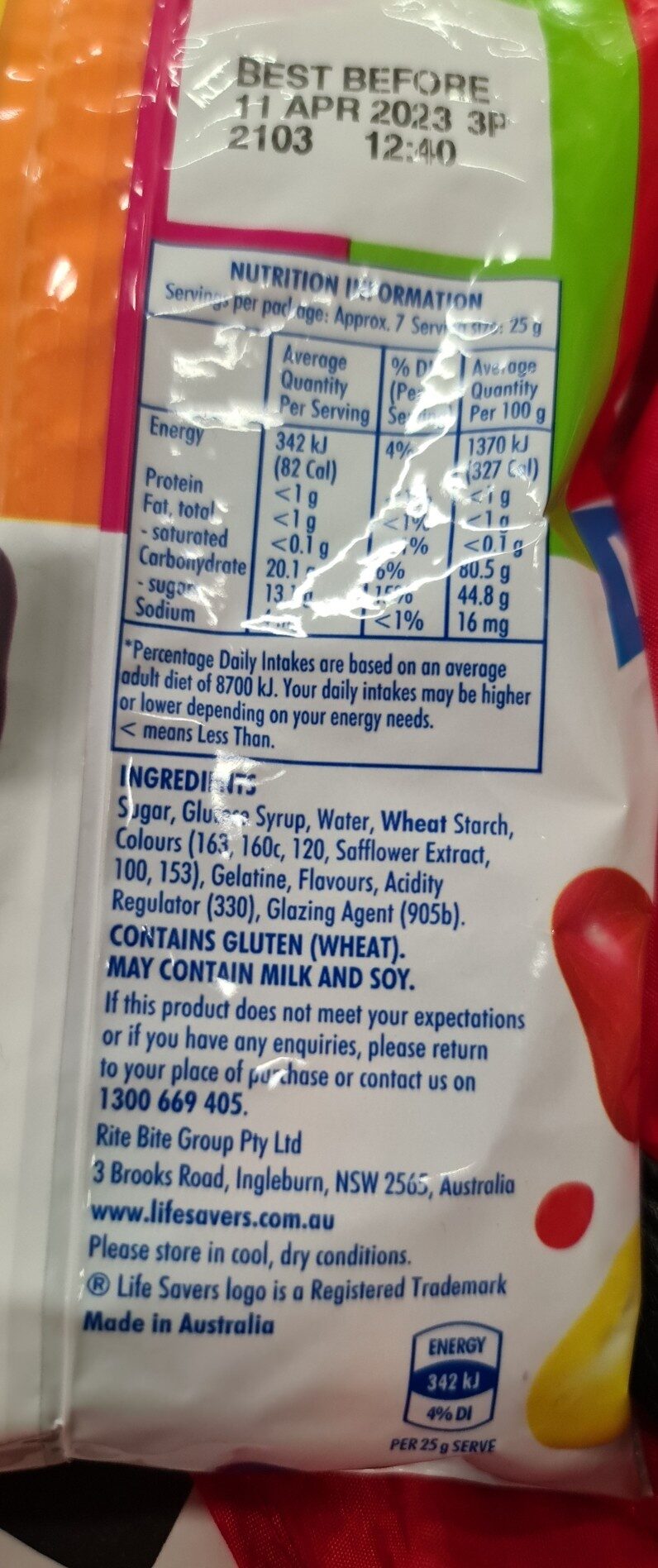Help us make food transparency the norm!
As a non-profit organization, we depend on your donations to continue informing consumers around the world about what they eat.
The food revolution starts with you!
Life savers jelly beans
Life savers jelly beans
This product page is not complete. You can help to complete it by editing it and adding more data from the photos we have, or by taking more photos using the app for Android or iPhone/iPad. Thank you!
×
Barcode: 9310881914770 (EAN / EAN-13)
Categories: Snacks, Sweet snacks, Confectioneries, Candies, Gummi candies, Jelly beans
Labels, certifications, awards: Australian made
Stores: Woolworths, Coles
Countries where sold: Australia
Matching with your preferences
Health
Ingredients
-
26 ingredients
sugar, glue syrup, water, wheat starch, colours (163, 160c, 120, safflower extract, 100, 153), gelatine, flavours, acidity regulator (330), glazing agent (905b). contains gluten (wheat). may contain milk and soy. if this product does not meet your expectations or if you have any enquiries, please return to your place of purchase or contact us on 1300 669 405. rite bite group pty ltd 3 brooks road, ingleburn, nsw 2565, australia www.lifesavers.com.au please store in cool, dry conditions. life savers logo is a registered trademark made in australia energy 342 kj 4% di per 25 g serveAllergens: GlutenTraces: Milk, Soybeans
Food processing
-
Ultra processed foods
Elements that indicate the product is in the 4 - Ultra processed food and drink products group:
- Additive: E100 - Curcumin
- Additive: E120 - Cochineal
- Additive: E153 - Vegetable carbon
- Additive: E160c - Paprika extract
- Additive: E163 - Anthocyanins
- Additive: E405 - Propane-1‚2-diol alginate
- Additive: E428 - Gelatine
- Additive: E905 - Synthetic wax
- Ingredient: Colour
- Ingredient: Flavouring
- Ingredient: Glazing agent
Food products are classified into 4 groups according to their degree of processing:
- Unprocessed or minimally processed foods
- Processed culinary ingredients
- Processed foods
- Ultra processed foods
The determination of the group is based on the category of the product and on the ingredients it contains.
Additives
-
E120 - Cochineal
Carminic acid: Carminic acid -C22H20O13- is a red glucosidal hydroxyanthrapurin that occurs naturally in some scale insects, such as the cochineal, Armenian cochineal, and Polish cochineal. The insects produce the acid as a deterrent to predators. An aluminum salt of carminic acid is the coloring agent in carmine. Synonyms are C.I. 75470 and C.I. Natural Red 4. The chemical structure of carminic acid consists of a core anthraquinone structure linked to a glucose sugar unit. Carminic acid was first synthesized in the laboratory by organic chemists in 1991.Source: Wikipedia
-
E163 - Anthocyanins
Anthocyanin: Anthocyanins -also anthocyans; from Greek: ἄνθος -anthos- "flower" and κυάνεος/κυανοῦς kyaneos/kyanous "dark blue"- are water-soluble vacuolar pigments that, depending on their pH, may appear red, purple, or blue. Food plants rich in anthocyanins include the blueberry, raspberry, black rice, and black soybean, among many others that are red, blue, purple, or black. Some of the colors of autumn leaves are derived from anthocyanins.Anthocyanins belong to a parent class of molecules called flavonoids synthesized via the phenylpropanoid pathway. They occur in all tissues of higher plants, including leaves, stems, roots, flowers, and fruits. Anthocyanins are derived from anthocyanidins by adding sugars. They are odorless and moderately astringent. Although approved to color foods and beverages in the European Union, anthocyanins are not approved for use as a food additive because they have not been verified as safe when used as food or supplement ingredients. There is no conclusive evidence anthocyanins have any effect on human biology or diseases.Source: Wikipedia
-
E330 - Citric acid
Citric acid is a natural organic acid found in citrus fruits such as lemons, oranges, and limes.
It is widely used in the food industry as a flavor enhancer, acidulant, and preservative due to its tart and refreshing taste.
Citric acid is safe for consumption when used in moderation and is considered a generally recognized as safe (GRAS) food additive by regulatory agencies worldwide.
-
E405 - Propane-1‚2-diol alginate
Propylene glycol alginate: Propylene glycol alginate -PGA- is an emulsifier, stabilizer, and thickener used in food products. It is a food additive with E number E405. Chemically, propylene glycol alginate is an ester of alginic acid, which is derived from kelp. Some of the carboxyl groups are esterified with propylene glycol, some are neutralized with an appropriate alkali, and some remain free.Source: Wikipedia
-
E905 - Synthetic wax
Microcrystalline wax: Microcrystalline waxes are a type of wax produced by de-oiling petrolatum, as part of the petroleum refining process. In contrast to the more familiar paraffin wax which contains mostly unbranched alkanes, microcrystalline wax contains a higher percentage of isoparaffinic -branched- hydrocarbons and naphthenic hydrocarbons. It is characterized by the fineness of its crystals in contrast to the larger crystal of paraffin wax. It consists of high molecular weight saturated aliphatic hydrocarbons. It is generally darker, more viscous, denser, tackier and more elastic than paraffin waxes, and has a higher molecular weight and melting point. The elastic and adhesive characteristics of microcrystalline waxes are related to the non-straight chain components which they contain. Typical microcrystalline wax crystal structure is small and thin, making them more flexible than paraffin wax. It is commonly used in cosmetic formulations. Microcrystalline waxes when produced by wax refiners are typically produced to meet a number of ASTM specifications. These include congeal point -ASTM D938-, needle penetration -D1321-, color -ASTM D6045-, and viscosity -ASTM D445-. Microcrystalline waxes can generally be put into two categories: "laminating" grades and "hardening" grades. The laminating grades typically have a melt point of 140-175 F -60 - 80 oC- and needle penetration of 25 or above. The hardening grades will range from about 175-200 F -80 - 93 oC-, and have a needle penetration of 25 or below. Color in both grades can range from brown to white, depending on the degree of processing done at the refinery level. Microcrystalline waxes are derived from the refining of the heavy distillates from lubricant oil production. This by-product must then be de-oiled at a wax refinery. Depending on the end use and desired specification, the product may then have its odor removed and color removed -which typically starts as a brown or dark yellow-. This is usually done by means of a filtration method or by hydro-treating the wax material.Source: Wikipedia
-
E905b - Petroleum jelly
Microcrystalline wax: Microcrystalline waxes are a type of wax produced by de-oiling petrolatum, as part of the petroleum refining process. In contrast to the more familiar paraffin wax which contains mostly unbranched alkanes, microcrystalline wax contains a higher percentage of isoparaffinic -branched- hydrocarbons and naphthenic hydrocarbons. It is characterized by the fineness of its crystals in contrast to the larger crystal of paraffin wax. It consists of high molecular weight saturated aliphatic hydrocarbons. It is generally darker, more viscous, denser, tackier and more elastic than paraffin waxes, and has a higher molecular weight and melting point. The elastic and adhesive characteristics of microcrystalline waxes are related to the non-straight chain components which they contain. Typical microcrystalline wax crystal structure is small and thin, making them more flexible than paraffin wax. It is commonly used in cosmetic formulations. Microcrystalline waxes when produced by wax refiners are typically produced to meet a number of ASTM specifications. These include congeal point -ASTM D938-, needle penetration -D1321-, color -ASTM D6045-, and viscosity -ASTM D445-. Microcrystalline waxes can generally be put into two categories: "laminating" grades and "hardening" grades. The laminating grades typically have a melt point of 140-175 F -60 - 80 oC- and needle penetration of 25 or above. The hardening grades will range from about 175-200 F -80 - 93 oC-, and have a needle penetration of 25 or below. Color in both grades can range from brown to white, depending on the degree of processing done at the refinery level. Microcrystalline waxes are derived from the refining of the heavy distillates from lubricant oil production. This by-product must then be de-oiled at a wax refinery. Depending on the end use and desired specification, the product may then have its odor removed and color removed -which typically starts as a brown or dark yellow-. This is usually done by means of a filtration method or by hydro-treating the wax material.Source: Wikipedia
Ingredients analysis
-
Palm oil content unknown
Unrecognized ingredients: 163, 160c, 120, 100, 153, 330, 905b, If-this-product-does-not-meet-your-expectations-and-if-you-have-any-enquiries, Please-return-to-your-place-of-purchase-and-contact-us-on-1300-669-405, Rite-bite-group-pty-ltd-3-brooks-road, Ingleburn, Nsw-2565, Www-lifesavers-com-au-please-store-in-cool, Dry-conditions, Life-savers-logo-is-a-registered-trademark-made-in-australia-energy-342-kj-4-di-per-25-g-serveSome ingredients could not be recognized.
We need your help!
You can help us recognize more ingredients and better analyze the list of ingredients for this product and others:
- Edit this product page to correct spelling mistakes in the ingredients list, and/or to remove ingredients in other languages and sentences that are not related to the ingredients.
- Add new entries, synonyms or translations to our multilingual lists of ingredients, ingredient processing methods, and labels.
If you would like to help, join the #ingredients channel on our Slack discussion space and/or learn about ingredients analysis on our wiki. Thank you!
-
Non-vegan
Non-vegan ingredients: E428Some ingredients could not be recognized.
We need your help!
You can help us recognize more ingredients and better analyze the list of ingredients for this product and others:
- Edit this product page to correct spelling mistakes in the ingredients list, and/or to remove ingredients in other languages and sentences that are not related to the ingredients.
- Add new entries, synonyms or translations to our multilingual lists of ingredients, ingredient processing methods, and labels.
If you would like to help, join the #ingredients channel on our Slack discussion space and/or learn about ingredients analysis on our wiki. Thank you!
-
Non-vegetarian
Non-vegetarian ingredients: E428Some ingredients could not be recognized.
We need your help!
You can help us recognize more ingredients and better analyze the list of ingredients for this product and others:
- Edit this product page to correct spelling mistakes in the ingredients list, and/or to remove ingredients in other languages and sentences that are not related to the ingredients.
- Add new entries, synonyms or translations to our multilingual lists of ingredients, ingredient processing methods, and labels.
If you would like to help, join the #ingredients channel on our Slack discussion space and/or learn about ingredients analysis on our wiki. Thank you!
-
Details of the analysis of the ingredients
We need your help!
Some ingredients could not be recognized.
We need your help!
You can help us recognize more ingredients and better analyze the list of ingredients for this product and others:
- Edit this product page to correct spelling mistakes in the ingredients list, and/or to remove ingredients in other languages and sentences that are not related to the ingredients.
- Add new entries, synonyms or translations to our multilingual lists of ingredients, ingredient processing methods, and labels.
If you would like to help, join the #ingredients channel on our Slack discussion space and/or learn about ingredients analysis on our wiki. Thank you!
en: sugar, glue, water, wheat starch, colours (163, 160c, 120, safflower, 100, 153), gelatine, flavours, acidity regulator (330), glazing agent (905b, wheat), if this product does not meet your expectations and if you have any enquiries, please return to your place of purchase and contact us on 1300 669 405, rite bite group pty ltd 3 brooks road, ingleburn, nsw 2565, www.lifesavers.com.au please store in cool, dry conditions, life savers logo is a registered trademark made in australia energy 342 kj 4% di per 25 g serve- sugar -> en:sugar - vegan: yes - vegetarian: yes - ciqual_proxy_food_code: 31016 - percent_min: 5.88235294117647 - percent_max: 100
- glue -> en:glue - percent_min: 0 - percent_max: 50
- water -> en:water - vegan: yes - vegetarian: yes - ciqual_food_code: 18066 - percent_min: 0 - percent_max: 33.3333333333333
- wheat starch -> en:wheat-starch - vegan: yes - vegetarian: yes - ciqual_proxy_food_code: 9510 - percent_min: 0 - percent_max: 25
- colours -> en:colour - percent_min: 0 - percent_max: 20
- 163 -> en:163 - percent_min: 0 - percent_max: 20
- 160c -> en:160c - percent_min: 0 - percent_max: 10
- 120 -> en:120 - percent_min: 0 - percent_max: 6.66666666666667
- safflower -> en:safflower - vegan: yes - vegetarian: yes - percent_min: 0 - percent_max: 5
- 100 -> en:100 - percent_min: 0 - percent_max: 4
- 153 -> en:153 - percent_min: 0 - percent_max: 3.33333333333333
- gelatine -> en:e428 - vegan: no - vegetarian: no - percent_min: 0 - percent_max: 16.6666666666667
- flavours -> en:flavouring - vegan: maybe - vegetarian: maybe - percent_min: 0 - percent_max: 5
- acidity regulator -> en:acidity-regulator - percent_min: 0 - percent_max: 5
- 330 -> en:330 - percent_min: 0 - percent_max: 5
- glazing agent -> en:glazing-agent - percent_min: 0 - percent_max: 5
- 905b -> en:905b - percent_min: 0 - percent_max: 5
- wheat -> en:wheat - vegan: yes - vegetarian: yes - ciqual_proxy_food_code: 9410 - percent_min: 0 - percent_max: 2.5
- if this product does not meet your expectations and if you have any enquiries -> en:if-this-product-does-not-meet-your-expectations-and-if-you-have-any-enquiries - percent_min: 0 - percent_max: 5
- please return to your place of purchase and contact us on 1300 669 405 -> en:please-return-to-your-place-of-purchase-and-contact-us-on-1300-669-405 - percent_min: 0 - percent_max: 5
- rite bite group pty ltd 3 brooks road -> en:rite-bite-group-pty-ltd-3-brooks-road - percent_min: 0 - percent_max: 5
- ingleburn -> en:ingleburn - percent_min: 0 - percent_max: 5
- nsw 2565 -> en:nsw-2565 - percent_min: 0 - percent_max: 5
- www.lifesavers.com.au please store in cool -> en:www-lifesavers-com-au-please-store-in-cool - percent_min: 0 - percent_max: 5
- dry conditions -> en:dry-conditions - percent_min: 0 - percent_max: 5
- life savers logo is a registered trademark made in australia energy 342 kj 4% di per 25 g serve -> en:life-savers-logo-is-a-registered-trademark-made-in-australia-energy-342-kj-4-di-per-25-g-serve - percent_min: 0 - percent_max: 5
Nutrition
-
Missing data to compute the Nutri-Score
Missing nutrition facts
⚠ ️The nutrition facts of the product must be specified in order to compute the Nutri-Score.Could you add the information needed to compute the Nutri-Score? Add nutrition facts
-
Nutrient levels
-
Fat in low quantity (0%)
What you need to know- A high consumption of fat, especially saturated fats, can raise cholesterol, which increases the risk of heart diseases.
Recommendation: Limit the consumption of fat and saturated fat- Choose products with lower fat and saturated fat content.
-
Saturated fat in low quantity (0%)
What you need to know- A high consumption of fat, especially saturated fats, can raise cholesterol, which increases the risk of heart diseases.
Recommendation: Limit the consumption of fat and saturated fat- Choose products with lower fat and saturated fat content.
-
Sugars in high quantity (52.4%)
What you need to know- A high consumption of sugar can cause weight gain and tooth decay. It also augments the risk of type 2 diabetes and cardio-vascular diseases.
Recommendation: Limit the consumption of sugar and sugary drinks- Sugary drinks (such as sodas, fruit beverages, and fruit juices and nectars) should be limited as much as possible (no more than 1 glass a day).
- Choose products with lower sugar content and reduce the consumption of products with added sugars.
-
-
Nutrition facts
Nutrition facts As sold
for 100 g / 100 mlCompared to: Jelly beans Energy 1,372 kj
(328 kcal)-9% Fat 0 g -100% Saturated fat 0 g -100% Carbohydrates 80.4 g -11% Sugars 52.4 g -23% Fiber 0 g -100% Proteins 4 g +24,290% Salt ? Fruits‚ vegetables‚ nuts and rapeseed‚ walnut and olive oils (estimate from ingredients list analysis) 0 %
Environment
-
Eco-Score B - Low environmental impact
⚠ ️Select a country in order to include the full impact of transportation.The Eco-Score is an experimental score that summarizes the environmental impacts of food products.→ The Eco-Score was initially developped for France and it is being extended to other European countries. The Eco-Score formula is subject to change as it is regularly improved to make it more precise and better suited to each country.Life cycle analysis
-
Average impact of products of the same category: A (Score: 89/100)
Category: Jelly candy
Category: Jelly candy
- PEF environmental score: 0.21 (the lower the score, the lower the impact)
- including impact on climate change: 1.57 kg CO2 eq/kg of product
Stage Impact Agriculture
51.7 %Processing
31.1 %Packaging
7.6 %Transportation
7.3 %Distribution
2.3 %Consumption
0.0 %
Bonuses and maluses
-
Origins of ingredients with a high impact
Malus: -5
Environmental policy: -5
Transportation: 0
Origin of the product and/or its ingredients % of ingredients Impact Unknown 100 %High Australia 0 %Medium
-
Missing packaging information for this product
Malus: -15
⚠ ️ The information about the packaging of this product is not filled in.⚠ ️ For a more precise calculation of the Eco-Score, you can modify the product page and add them.
If you are the manufacturer of this product, you can send us the information with our free platform for producers.
Eco-Score for this product
-
Impact for this product: B (Score: 69/100)
Product: Life savers jelly beans
Life cycle analysis score: 89
Sum of bonuses and maluses: -20
Final score: 69/100
-
Carbon footprint
-
Equal to driving 0.8 km in a petrol car
157 g CO² per 100g of product
The carbon emission figure comes from ADEME's Agribalyse database, for the category: Jelly candy (Source: ADEME Agribalyse Database)
Stage Impact Agriculture
36.9 %Processing
38.1 %Packaging
11.9 %Transportation
12.0 %Distribution
1.1 %Consumption
0.0 %
Packaging
-
Missing packaging information for this product
⚠ ️ The information about the packaging of this product is not filled in.Take a photo of the recycling information Take a photo of the recycling information
Transportation
-
Origins of ingredients
Origins of ingredients with a high impact
Origin of the product and/or its ingredients % of ingredients Impact Unknown 100 %High Australia 0 %Medium
Report a problem
-
Incomplete or incorrect information?
Category, labels, ingredients, allergens, nutritional information, photos etc.
If the information does not match the information on the packaging, please complete or correct it. Open Food Facts is a collaborative database, and every contribution is useful for all.
Data sources
Product added on by inf
Last edit of product page on by arise001.
Product page also edited by archanox, kiliweb, roboto-app, yuka.sY2b0xO6T85zoF3NwEKvln13Q9_QoTucHDnTvX2VwvqTd4fnTcAj8NCjaKo.










